Peter MALONE
Saturday, 18 September 2021 19:42
Small Town in Texas, A
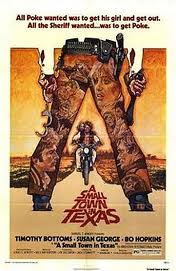
A SMALL TOWN IN TEXAS
US, 1976, 96 minutes, Colour.
Timothy Bottoms, Susan George, Bo Hopkins, Morgan Woodward, Art Hindle.
Directed by Jack Starrett.
A Small Town in Texas is a violent contemporary western. Timothy Bottoms portrays a young man who comes out of jail to meet his girlfriend but finds she has taken up with the sheriff and he is framed by the sheriff on a drug charge. He also witnesses the sheriff committing a murder. This sets up a confrontation between the two – with the hero either escaping or standing up to the sheriff.
Timothy Bottoms was a popular star in the 1970s with such films as The Last Picture Show and Love and Pain. Susan George had come from Britain after appearing in a number of films including Straw Dogs. Bo Hopkins was a regular in action films of the 1970s. Director Jack Starrett made a number of tough action films and television programs during these years including Cleopatra Jones, Slaughter, Race with the Devil.
1. The focus of the title on the town, localizing it in Texas, the overtones of Texas? Yet indefinite enough to give a universal theme?
2. Texas and the background of the 19th century West, Texas in the 20th century still in the West, expectations about Texas, America, American small towns?
3. The colour, the recreation of the town, the farms, the roads? Panavision? Music?
4. How ugly was the small town in Texas, its atmosphere, people, political and moral corruption, injustice? How pessimistic was the outlook of the film? How much hope about human nature? society? The individual in society?
5. The device of having the audience enter the theme and the town with Poke? The audience identifying with him? What kind of character was Poke? A limited young man? Slow-witted? The audience seeing and feeling the town and its people with this kind of man?
6. Poke's strengths and weaknesses as a character? The charge and the drug situation of five years earlier? How much justice had been done wibh such a sentence, such a sentence being served? Audience judgement about the justice and preparation for further Injustice towards Poke? How did the film communicate his sense of bewilderment on his return from prison, arriving in the town, people's attitudes, meeting him and remembering him, his visit to the farmhouse, the discovery of his girlfriend's infidelity, seeing his son again, being immersed in the problems of the town?
7. Mary Lee as a character, her relationship with Poke, her youth, waiting five years for him, Kevin and her mothering of him? Her relationship with Duke? An ordinary character involved in situations bigger than those she could cope with? Her involvement with Kevin in the great chase? A convincing small town character?
8. Duke as the contrast with Poke? His role in securing Poke's imprisonment, his rising to Sheriff? His smugness, liaison with Mary Lee? The gradual discovery that he was dishonest and corrupt? His being in the pay of the big business interests? Audience response to the revelation that he was an assassin? The build?up of his vengeance on Poke after his discovery about the money? His toadying to Crane? Being rejected by him? The desperation of his chase, vindicating himself, getting the money? The poetic justice of his death? An evil character who had the same chances as Poke?
9. How did the film build up Poke's predicament, the fair, the political background, seeing the assassination, discovering the money? His decision to take the money, go away, get the bike? His dependence on his friends? The chase and the irony of his being wanted as a killer? His not being believed, his being categorised? The necessity for escaping, getting Mary Lee and Kevin? The reaction to Duke's death? The importance of his returning to clear his name?
10. The film's portrayal of the big men in small towns and their business interests, corruption, using people, using assassinations? Crane and his duplicity? was it credible? His use of Duke, rejecting him?
Published in Movie Reviews
Published in
Movie Reviews
Tagged under
Saturday, 18 September 2021 19:42
Slippery Slide
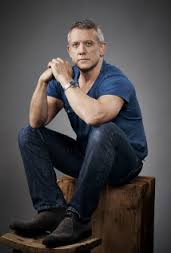
SLIPPERY SLIDE
Australia, 1980, 58 minutes, Colour.
Simon Burke, John Waters.
Directed by Donald Crombie.
Slippery Slide is a brief telemovie, sponsored by the Tasmanian Film Commission For Government Welfare Agencies. Direction is by Donald Crombie, maker of such feature films as Caddie, The Irishman, Cathy's Child. He also made an acclaimed short telemovie, Do I Have To Kill My Child? The film is strong in its cast, especially with Simon Burke from The Devil's Playground and John Waters. There is excellent photography, precise editing and the film has strong content as well as for such a brief film. It was intended for discussion and it achieves this well.
1. The impact of the film, entertainment, message? Brevity and impact? The strength of the plot, characterisation? The impact of the message and audience response to it? The government sponsorship?
2. Tasmanian production, interstate cast, director? The technical credits?
3. An atmosphere of realism in plot and character? Contrived for the purposes of the film and brevity? Observation of social situations and problems, portrayal of complex issues? The film's judgment on its characters, on society? Audience judgment?
4. The significance of the prologue: indication of facts, creation of a mood, a statement about situations in past decades, about the law and its administration, personal feelings of people involved? Parents and their ability to look after their children, failures? Adoption? The prospects for the neglected and then adopted chilaren?
5. The portrayal of foster parents? appropriately, fairly? The Dixons and the reasons for adopting Steven, the sense of duty, wanting to help? The effect on the husband and wife, their home life? What they gave to Steven over the years? The initial surface happiness? Tensions? The importance of the grandfather coming and claiming Steven's room, the parents allowing the grandfather to have it? The history of the grandfather's coming? The plea for himself to stay there and his not wanting to stay in the home? The family unable to cope? Steven and his place in the family, his calling his foster parents Mum and Dad, his knowledge that he was adopted? Going to the disco, their concern? The return and his lateness? His going to the courts, his behaviour, especially with taking the car and being chased by the police, the parents refusing to take him back, the growing rejection? Their return visit and the failure in being able to establish family patterns again?
6. The portrait of Steven's real mother and father? His father and the letter, the romanticism, Steven's unwillingness to face the facts, his hitchhiking and taking the car? His mother and her de facto husband? Her love for her son yet her inability to do anything about it? The hostility of the de facto husband? The cruelty experienced by Steven from his real parents?
7. The portrait of Steven as a boy of the 70s? The memory of his brother's death and its effect on him? The importance of his memories? His going to the dance, winning a prize, school sequences, playing truant and seen by his father, taking the car and being chased by the police, the car to go to see. his father, the encounter with the homosexual driver, his love for Alana and the problem of the abortion, his participating in the robberies? The anger within him, fears, always in reaction? His going to the courts, under parole, the friendship with David Wilding and the possibility of rehabilitation? The boys' home, the jokes, his fear of getting used to it? The sequences illustrating his life in the home? Getting the flat, Doug's return and Steven's smashing everything? The significance of his final words for his future?
8. The contrast with Alana and her being with the Methodist family, strictness, her attitudes and behaviour at the dance, flirting, Doug, the pregnancy, wanting to have the abortion, the robberies, the flat and her siding with Doug against Steven?
9. David Wilding and his representing compassion? The possibilities of helping Steven, seeking him out, taking a firm stand? The meetings of the parole board intercut with Steven's behaviour? The significance of his plea to the board? The flat? His visit to Steven in the home? The helplessness in the compassion?
10. The portrait of Australian society - perennial problems, the challenging of values; people trying to cope, hardness of attitudes, chances for children, managing to cope with problems, the role of the law, institutions, prison? Hopes, reforms? Compassionate awareness? What was the audience left with?
Published in Movie Reviews
Published in
Movie Reviews
Tagged under
Saturday, 18 September 2021 19:42
Sleeping Car Murders, The/ Compartiment Tuers
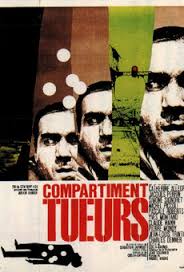
THE SLEEPING CAR MURDERS (COMPARTIMENT TUERS)
France, 1965, 95 minutes, Black and white.
Catherine Allegret, Jacques Perrin, Simone Signoret, Michel Piccoli, Pascale Roberts, Yves Montand, Charles Denner, Jean-Louis? Trintignant, Bernadette Lafont.
Directed by Costa-Gavras?.
The Sleeping Car Murders is a thriller, the first feature film by Costa- Gavras. However, in four years he was to become famous worldwide with his Oscar for the political film, Z. He had a very successful 1970s with his very strong political films after Z. They include The Confession, State of Siege, Special Section. In the 1980s he made Missing and Hanna K., as well as the American films Betrayed (about the Ku Klux Klan), and Music Box (about Nazi war trials). In the 1990s he made Mad City in the United States with John Travolta about a siege and the work of a journalist. Finally he made Amen, a film version of Rolf Hocchuth’s (**IMDB: Hochhuth) The Deputy, the film attacking Pius XII for collaboration with the Nazis.
This film is an entertaining murder mystery – enhanced by a top-rate cast of distinguished French actors.
1. The appeal of the murder mystery, the crime, clues, puzzle, characters? Detection? The quality of this murder mystery in terms of puzzle and clues, detection?
2. A French murder mystery, the use of so many prominent French film stars, the career of the director whose main interest was political? Black and white photography, Cinemascope, contemporary music and suspense themes? Possibility of audience identification with characters?
3. The atmosphere of the train, the movement of the train, the compartment, the transition to Paris, the city, police department, police work? Audience interest in the police work?
4. The introduction to the crime and detection via Daniel and Bambi? sympathy for them? Their stories of coming to the city, running away from school, hiding in the toilet and avoiding the ticket collector? The gradual involvement of Daniel, the danger to Bambi, their involvement in the crisis and the solution? The fact that they were young, audience attraction towards the young?
5. Was the film fair in presenting the mystery, sufficient clues?
6. The personality of the inspector, his role, boss, style, cold, his meeting with his wife, his work with his assistant, the continual harrassment? His clarity in working? His putting the clues together finally? A good example of a congenial detective?
7. The portrayal of the witnesses, their families? How real did the crime seem with such attention to detail on the train, the interviewing of various witnesses and family? The dead woman's sister and brother?in?law and their incessant talking? The workerwho was murdered and the sadness of his wife?
8. The focussing on Cavour on the train, his lustful attitudes towards the victim? Her brushing him off? The visualising of his story, his worry about reporting to the police, his visit to the boxing match, the impact of his being killed? A good character sketch of such a man?
9. The character sketch of Elaine Darras? As an actress, her style, her image of herself? On the train, her apartment with the gigolo? Her reaction towards the police? Her involvement in the mystery? The device of the letter being read by Daniel and Bambi? The visualising of the letter and the flashback technique for revealing the character of Darras, her work, visit to the vet with dog, growing infatuation with Eric? The ups and downs of their relationship, his youth, her age, her infatuation? The meaning of money? The clue to the ultimate solution of the mystery? Her murder and its impact? An effective character study of this kind of woman?
10. How important was Eric? The delineation of his character, work as a vet, his leading on of Elaine Darras, his life as gigolo? Gradual revelation of his involvement? His menacing Daniel in the bar? His breaking down and confessing to the police? A credible kind of villain?
11. The first victim's boyfriend, his incessant chatter, his being framed as regards collecting the money, the humour and irony of his critique of the police?
12. The character of the assistant detective, his access to information, his motivation for the crime? The fact that he took Daniel's phone call? The buildup to the denouement? Daniel in the phone, the hotel and the rescuing of Bambi? The build-up to the chase, the crash and the shootout? The murderer killing himself? An appropriate build-up of suspense for this kind of murder mystery? Audience interest and sympathies?
13. How much genuine character study is there in this kind of film? Analysis of human nature, good and evil, crime?
Published in Movie Reviews
Published in
Movie Reviews
Tagged under
Saturday, 18 September 2021 19:42
Slaves
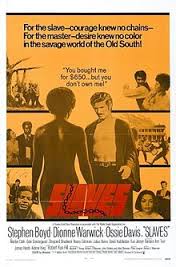
SLAVES
US, 1969, 110 minutes, Colour.
Ossie Davis, Dionne Warwick, Stephen Boyd, Nancy Coleman, Julius Harris, David Huddleston, Gale Sondergaard, Shepperd Strudwick.
Directed by Herbert J. Biberman.
Slaves is a film about a revolt in the south, a Kentucky slave who is sold to a cruel master (who has a black mistress). The slave is played by Ossie Davis, the master by Stephen Boyd and the mistress by singer Dionne Warwick.
The film is conventional in its presentation of slavery as well as the revolt. However, the film is of historical interest because of its co-writer director. Herbert J. Biberman was one of the Hollywood Ten, blacklisted from Hollywood along with his wife, Oscar-winning actress Gale Sondergaard. Biberman had made The Master Race in 1944 and was only able to make another film, independently about a New Mexico civil and industrial disturbance, Salt of the Earth, in 1954. Slaves was his only film after Salt of the Earth and the first film that Gale Sondergaard was able to appear in for twenty years.
The film is interesting insofar as it offers a perspective by Biberman with his own experience of oppression in the United States.
1. The emphasis of the title and indication of theme? Slaves as a film of the late 1960s? Reflecting American concerns at the time? Subsequent impact?
2. The quality of the colour, locations? The re?creation of 19th century atmosphere? The use of music and song?
3. Did the film have a 1960s outlook on America, blacks and the slave issue? America and its conscience and guilt?
4. The importance of the opening sequences? The sympathetic master? The Stillwell household and the way it was run? The possibilities for slaves? Luke and his ability to prosper in this situation? Stillwell caught by the machinations? The pressures on him to sell his slaves, though unwillingly? Fate and the impossibility of escaping it?
5. The film's focus on Luke? His status in the Stillwell household, taking its name? The fact that he had to be sold? The importance of the sequences with his wife?
6. The impact of the sale? The separation of husband and wife, the grief, the sense of hopelessness? The emotional response of the audience to this?
7. How well presented was the slave market at New Orleans? The nature of the sale, the humiliation of the slaves and their presentation, the comments of the buyers, the corments of the New Orleans lady about slavery?
8. McKay? as seen in this particular context? Being introduced to him in New Orleans? How did he typify the plantation owners and the slave masters? The vigorous young man and his arrogance? his sympathy towards black culture, the decorations and adornment of his house? his mistress? And yet his sadistic attitudes towards the slaves? His torture and the details of his humiliating of the slaves? The ambiguity in the American slave owner? How plausibly explored was this theme?
9. The character of Cassy and her role in this household? Her hair and clothes, her status? Yet her humiliation and her drinking? Her attitude towards McKay? Her attitude towards Emmaline as she came into the house? Her wanting to kill McKay? Luke's influence in persuading her not to? Her desperate need to escape?
10. What happened to Luke in this new household? His standing on principles, his mouthing of his religious beliefs and their being tested? His torture and whipping? His determination that the little baby should not be a slave? His involvement in her birth? His plans for the escape? The fatality of his death? How futile was Luke's life?
11. The characterization of Jericho, his sale, his place in the Mc Kay household, his torture, his escape?
12. The importance of the presentation of the details of the slaves' life, their work In the fields, their housing conditions, the humiliation, the sexual abuse etc.?
13. McKay? and his friends? The landowners? The criticism of the cousin from the north? His drunkenness and his almost being killed? His killing of Luke?
14. The fire and its effect on McKay?
15. The savagery after the escape? The fact that there were more blacks to pursue? This as a condemnation of the arrogant attitude of the Americans?
16. Critics were very hostile to the film. Why? They said it was pretentious and a set?back to civil rights causes. Is this evident from the film? how well did the film explore America and its racial heritage? questions of human dignity, slavery and freedom?
Published in Movie Reviews
Published in
Movie Reviews
Tagged under
Saturday, 18 September 2021 19:42
Slavers
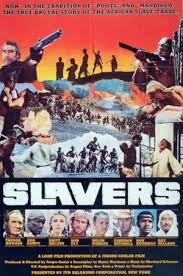
SLAVERS
US/West Germany, 1978, 103 minutes, Colour.
Trevor Howard, Britt Ekland, Ron Ely, Cameron Mitchell, Ray Milland, Ken Gampu.
Directed by Jurgen Goslar.
Slavers is a portrait of the end of the slave era in the 1880s. It is situated on the west coast of Africa. The film shows slave owners, the clashes amongst themselves – especially as the supply of slaves is dwindling.
While the film has a number of scenes of callous treatment of slaves, it also has some of the characters coming to some realisation of the evils of the trade and an awareness of aspects of human dignity.
The film came out in the aftermath of the miniseries Roots on American television which raised the consciousness in the popular audience of issues of African slaves and the slave trade.
The director is German – as is some of the supporting cast while most of the main cast are veterans of film and television.
1. The entertainment value of the film? Historical background? Message? For what audience was it made?
2. The film reflecting the trends of the seventies? Roots, Mandingo? Interest in race? Violent trends, exploitation?
3. The film as a British- German co-production? European styles? Stars? The values?
4. The points of view of the film makers? Their judgments about slavery, about Europeans involved in slavery? About the Africans and their plight?
5. The importance of the prologue? The European setting, the duel? Germany, Von Erck and his wife? Their arrogance and violence? To be transferred to Africa?
6. The transition to the slave raid and the types involved? Especially Hassan? The African traders themselves? The violence and the humiliation?
7. How well did the plot bring the German background together with the slave situation? The situation in Africa itself?
8. The slavers and their personalities, their double?dealing, cruelty: Hassan, Massumo, Da Silva?
9. The characterization of Von Erck and his wife? Their mission for exploring for Germany. the violence and the dangers, the sequence on the rapids and his death?
10. Stephen Hamilton as an adventurer? His involvement in Africa, his presence there, fighting? His reaction to the slavers? His involvement with Von Erck's wife?
11. The portrait of the Africans and their motivations? The slave hero and heroine?
12. The focus on McKenzie? as a typep his arrogant style, the truth about him, his death?
13. The value of this kind of re-creation of Africa? Visual impact? The point behind the film?
Published in Movie Reviews
Published in
Movie Reviews
Tagged under
Saturday, 18 September 2021 19:42
Slave of the Cannibal God
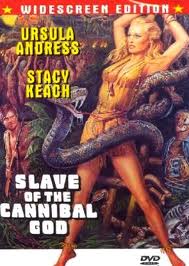
SLAVE OF THE CANNIBAL GOD
Italy, 1978, 99 minutes, Colour.
Claudio Casinelli, Stacy Keach, Ursula Andress.
Directed by Sergio Martino.
One of the "spaghetti horror" of the late seventies. The Italians in the sixties and seventies took over so many of the American genres and made them their own especially "spaghetti" westerns and "spaghetti" police films. The Italians highlight the conventions of the genre and present the characters and situations in somewhat melodramatic and even operatic tone. The treatment is also gory and violent - and many censors have considered it excessive. This was the case with this film with its presentation of New Guinea cannibals. There are also some earlier gory deaths in the film. Examples of the genre include Contamination, Zombie Flesh Eaters and a film by the present director Sergio Martino, Island Of The Fish Men. The "spaghetti" horror also uses an international cast and this film features Stacy Keach and Ursula Andress. However. the hero is played by Claudio Casinelli, the hero of Island Of The Fish Men. The material of this film is conventional exploration horror. There is a mission in New Guinea and a group go out into the jungle, meet all kinds of difficulties and dangers and eventually confront cannibals. The climactic sequence has escape as well as a twist about exploitation of natural resources. For those not keen on excessive gore and horror, the film will not be of interest. For those interested in Italian developments of horror genres, of some interest.
1. The quality of this kind of adventure horror? Entertainment, censors cutting or banning such films?
2. The impact of horror: nightmare, monsters, death and suffering? Audiences being entertained by looking into horror and nightmare?
3. Colour photography, jungle locations in New Guinea, Panavision? The Italianate musical score? The use of international casts? Stacy Keach and his prestige, Ursula Andress and her sensuality and glamour? How were these used in the film?
4. The atmosphere of horror ? the threat of the jungle, tribes, animals, natural dangers, the cannibals and ritual and torture? How excessive the visual presentation of horror?
5. The contemporary setting? The atmosphere of Port Moresby, officialdom, explorations and disappearances of scientists, the conventions of the group going searching, the hero guide, the brother and sister searching, etc.? The wife looking for her husband? How well were these used? How plausible an atmosphere of realism? how long did this continue into the film?
6. The presentation of New Guinea - the flight, the jungles, animals and threats, the risks of death, the violent deaths within the group, even of the guide? Natural beauty, natural menace?
7. The background of the peoples of New Guinea, the priest and his mission, the natives and the violence, the atmosphere of ritual and superstition? The build-up to the cannibals and their violence and ritual?
8. The sketching in of the characters - how conventional, the interactions, violence, sensuality? Capture, betrayal? The truth about the purpose of the mission? Greed? The violence consequent on greed? The final rescue?
9. The climax on the island after the difficulties in getting there, the natural eruptions, the cannibals and their rituals, the final fight and rescue - matinee material designed for science fiction horror?
10. How satisfying an entertainment? A use of adventure genres for fable purposes (with gore!)?
Published in Movie Reviews
Published in
Movie Reviews
Tagged under
Saturday, 18 September 2021 19:42
Slave of Love, The/ Raba Lyubvi
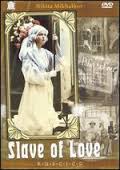
RABA LYUBVI (THE SLAVE OF LOVE)
USSR, 1976, 99 minutes, Colour.
Yelena Solovey, Rodion Nahapetov.
Directed by Nikita Mikhalkov.
A Slave of Love is a film about the silent cinema in Russia. However, it is also a film about white Russians and the communists and their clashes.
The film focuses on a glamorous silent screen star, whose films are sought out by underground revolutionaries in order to see them and admire them. While she is on location near the Black Sea, she is involved in an affair with the cameraman – however, he is undercover filming alleged white atrocities while waiting for the Red Army to advance.
The film reflects communist thinking and propaganda of the period.
However, it was written and directed by one of Russia’s major directors, Nikita Mikhalkov (and co-written by his brother Andrei Konchalovsky). Mikhalkov became a celebrated figure in Russia after the fall of communism and made many fine films including the autobiographical Burnt By The Sun. His brother, Andrei Konchalovsy, moved to the United States and made a number of films in the 80s and 90s there – returning to Russia and making films in Russia as well as in the United States.
The film was praised for its sense of atmosphere, location, and its perspective on the revolution as well as on Russian cinema.
The Slave of Love achieved great popularity in the United States in 1978 and then in other parts of the English-speaking world. The film is an accessible Russian feature and has many aspects of charm, comedy as well as its social message? Very strongly adhering to the Russian party line, it shows the frivolity of the way of life in Czarist Russia and shows a change of heart in the leading lady in her involvement in revolutionary activity and in her being victimised at the end. The film is strong in its performances but has special attraction in its portrayal of the early Russian film industry and its'detail. There is much humour and social observation here. The counterpoint of the use Slave of Love of film for recording the ugly events and the use for propaganda is also strongly presented. The film is interesting, entertaining and a useful example of the techniques and content of Russian films of the seventies.
1. The tone of the title, its meaning? Reference to the film being shown? To Olga herself? Indication of themes?
2. The quality of the Russian production? Colour, atmosphere, locations, the Russia of the provinces in the early 20th century? The film's attention to period, decor, costumes? The focus on Russian films and the film industry? Its impact throughout the towns? The use of film for entertainment, for propaganda, for revolution? For recording brutal facts? The contrast between entertainment and documentary? The attention to film techniques and filmmaking? The linking of film to the revolution?
3. The Russian view of the Czarist period and the Revolution? The attention to detail in life under the Czars, as symbolised by the film's being made? Wealth, idleness, an ambiguous attitude toward problems, ignoring them? The revolutionaries and their cause? Fedotov and his cruelty, the Czarist police, the prologue with the film being shown and audiences laughing and crying and the sudden eruption of the soldiers, their brutality and arrests? The film's emphasis on the brutality of the Czarist regime? Olga's curse at the end and her appeal to the judgment of history?
4. The detail of the film world and its frivolity? Sets, styles, techniques of silent filmmaking? Locations? Personalities and the various clashes and conflicts? Directorp producer and their personalities, persuasion, budgets, timetables? The role of the piano player? Actors and actresses? Technical assistance? How well did the film show the interplay between all these characters? Echoing the type of film being made? The importance of finishing the film?
5. Olga and her place within this atmosphere? As a famous actress, on all the posters, her frivolous attitude, her moods, her being pampered? The sequences with her mother, her children? The memories of her husband and his death? How well did the film show the growing attraction towards Viktor? Its turning into tenderness and love? How did she change with her experience of Viktor's attention? The authenticity of the scenes between them, their conversations and expressions of love? The sequence at the cafe and the transition to Viktor's death? The repercussions of his death and her presence at the revolutionary films? Her being affected by the films, stunned by Viktor's death? Her reaction in not wanting to finish the film, her going to the set, her shooting the blanks at Fedotov? Her attacking the seeming traitor? The attack on the film set, her giving of the film to the revolutionaries, her rescue and being put on the tram? Her becoming a revolutionary and realizing this? The impact of her being on the runaway tram and the Czarist soldiers pursuing her? 6. Viktor as hero? His work with films, his political connections, a pleasant character and attracted towards Olga? The love between the two? The importance of his political involvement and the brutality of his death? The cause of such men? The impact on ordinary citizens like Olga?
7. The film's presentation of Fedatov and his brutality? The arrests, the executions? The presence on the film set and the attack, Fedotoy hiding in the water, his death? The tram driver and the Czarist soldiers pursuing the tram? Did this explain the Revolution and its background?
8. A glimpse at a small section of Russian society at the time of the Bolshevik Revolution? A microcosm for what was happening in Russia? How credible were the people and the way of life, involvement? The issues?
9. The impact at the end of the film with audiences watching Olga, experiencing her change, her in love and involvement? Her being pursued as victim, symbolizing the Russian people?
Published in Movie Reviews
Published in
Movie Reviews
Tagged under
Saturday, 18 September 2021 19:42
Slaughter's Big Rip Off

SLAUGHTER’S BIG RIP OFF
US, 1974, 92 minutes, Colour.
Jim Brown, Ed Mc Mahon, Don Stroud, Brock Peters, Gloria Hendry, Dick Anthony Williams.
Directed by Gordon Douglas.
Slaughter and Slaughter’s Big Rip- Off were features for ex-footballer Jim Brown. He had appeared in such films as The Dirty Dozen as well as topical films like The Slams. However, after Shaft and the various blacksploitation films of the early 1970s, Slaughter became an iconic figure.
The films are generally revenge films. Brown appears as a Vietnam veteran and has to avenge deaths caused by the Mob, even being asked by the FBI to go to Mexico to eliminate other Mobster connections. In Slaughter’s Big Rip- Off, the action is doubled – but a similar theme and plot.
The films show the thinking about black characters on screen in the early 1970s, a breakthrough from the previous decade. However, the films were directed by white action directors, Jack Starrett (Race with the Devil, Small Town in Texas, Cleopatra Jones) and veteran director Gordon Douglas from the 1950s to the 1970s.
The films also feature some black character actors in supporting roles. They echo the attitude of the times, especially during the Vietnam war and popular feeling about the war. They are also influenced by The Godfather and Godfather II, produced at the same time and giving prominence to the Mafia on screen.
1. The tone of the title, emphasis on Slaughter, rip-off and the size? The value of the film as a sequel, relationship to the original, exploitation of the original, box office hopes? Jim Brown and his style? A commentator said it was a typical film about blacks, blood and bullets. Is this an adequate comment?
2. Impact of action films, audience entertaininent by action, melodrama, violence? The size and impact of the violence and action? Exploitive?
3. Colour, wide screen, music, flashy photography styles, aerial photography, swift editing for action and violence? An appropriate style for this kind of action thriller?
4. Interest in the plot: the background of the syndicates, gangsters, sex and violence?
5. Slaughter as a hero? Jim Brown and his style, vigil? The vigilante approach to justice? Background of the Green Berets, suffering personal injustice, violence? His aggression against society? The decadent society which he attacked?
6. Comment on the presentation of the action and how convincing it was? In such an ugly world, black, white, clashes of the races? Slaughter purging this decadent world?
7. The character of Slaughter with his Green Beret background, the effect of killing, the club, Reynolds, the bond with Marcia, involvement in the rackets, the world of drugs, Duncan, creole?
8. The portrayal of the villains? conventional for this kind of material? Characters? Kirk as a contrast with Slaughter? The Karate men? Croydon?
9. The build-up to the big showdown, the melodrama, the violence, Slaughter and his interpretation of justice and his administering of it, relationship to official law and order?
10. What is the value of this kind of film? Does it stand for sound social values?
Published in Movie Reviews
Published in
Movie Reviews
Tagged under
Saturday, 18 September 2021 19:42
Slaughter
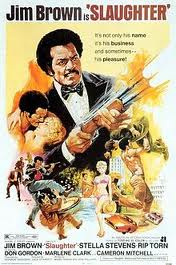
SLAUGHTER
US, 1972, 91 minutes, Colour.
Jim Brown, Stella Stevens, Rip Torn, Cameron Mitchell, Don Gordon.
Directed by Jack Starrett.
Slaughter and Slaughter’s Big Rip-Off? were features for ex-footballer Jim Brown. He had appeared in such films as The Dirty Dozen as well as topical films like The Slams. However, after Shaft and the various blacksploitation films of the early 1970s, Slaughter became an iconic figure.
The films are generally revenge films. Brown appears as a Vietnam veteran and has to avenge deaths caused by the Mob, even being asked by the FBI to go to Mexico to eliminate other Mobster connections. In Slaughter’s Big Rip- Off, the action is doubled – but a similar theme and plot.
The films show the thinking about black characters on screen in the early 1970s, a breakthrough from the previous decade. However, the films were directed by white action directors, Jack Starrett (Race with the Devil, Small Town in Texas, Cleopatra Jones) and veteran director Gordon Douglas from the 1950s to the 1970s.
The films also feature some black character actors in supporting roles. They echo the attitude of the times, especially during the Vietnam war and popular feeling about the war. They are also influenced by The Godfather and Godfather II, produced at the same time and giving prominence to the Mafia on screen.
1. The value of this kind of entertainment? For what audience?
2. Use of colour, wealthy locations, people? The atmosphere of vealth, crime? As a reflection of American society?
3. The "blacks-ploitation" aspect of the film: For a negro audience, vhy? Impact for a vhite audience?
4. Jim Brovn and audience response to him? Negro hero? The conven¬tions of the American private eye film as applied to the negro situation, self-assertion, anti-white? Equality of the races? The significance of the title as the hero's name?
5. The conventions of action and crime melodrama? How interesting and enjoyable? Pace? The presentation of sex and violence in this context? Appropriate, exploited?
6. Slaughter as a character: As portrayed by Jim Brovn and his style, the Vietnamese background? His father and his father's mis¬tress? The mystery of his death? Audience involved with the investi¬gation? His allies especially Kirn Walker and Bastoli? The confron¬tation with enemies? Slaughter as a tough American type? Sense of right and wrong, values? The use of violent means to attain an end? (Any better than his adversaries?)
7. Slaughter in action: the confrontation with Jenny and her death? Confrontation with Felice? The clash with Ho... ? The friendship with Bastoli and their working together? The number of deaths, the torture and violence? The confrontation with Anne Cooper? Sexuality? Rivalry with Ho... ? The scenes of them together, black and white? The confrontation at the end and his being vindicated? Were audiences satisfied?
8. Bastoli and Kim Walker and their characters, being pro-Slaughter, the way in which they helped?
9. The presentation of Felice and the type of wealthy criminal background that he represented? His interests, way of acting, hold over people?
10. Ho... as the villain, the type, his relationship with Anne Cooper, the murder, his being kidnapped, confessing, the violence of his death? Conventional villain?
11. Stella Stevens’s Anne Cooper and the type of American woman that she represented? With Ho... , with Slaughter?
12. The background of the syndicate, wealth, violence? Credible, interesting?
13. The build-up of the action sequences and their style? The buildup to the ending? A valuable kind of entertainment? Transient?
Published in Movie Reviews
Published in
Movie Reviews
Tagged under
Saturday, 18 September 2021 19:42
Slap, The/ La Gifle
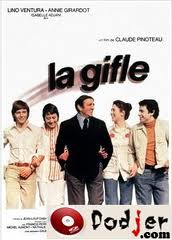
LA GIFLE (THE SLAP)
France, 1974, 104 minutes, Colour.
Lino Ventura, Annie Girardot, Isabelle Adjani, Nicole Courcel, Francis Perrin, Michel Aumont, Robert Hardy, Nathalie Baye, Xavier Gelin, Georges Wilson.
Directed by Claude Pinoteau.
The Slap is a French comedy of the 1970s – with some excursions across the channel to England. The film focuses on an eighteen-year-old girl, played by the eighteen-year-old Isabelle Adjani, at the beginning of her long career. Her parents are played by veterans Lino Ventura and Annie Girardot. The film looks at the problems of relationships between the generations, the development of the young girl, the tensions with the parents. It is conventional material – but done particularly well because of the strong cast.
1. The title of the film, impact and the tone, expectations?
2. The impact of the film on a French audience, non-French audience? Nature and reasons for differences?
3. How important was French sensibility? Colour, locations, atmosphere? Modern French living? Music? The locations of Paris, the city, universities, the world of teaching? The contrast with England? A glimpse of a cross-section of the modern world and its characters? How easy was it for the audience to identity with the characters and situation, the issues? Enjoyably?
4. How engaging a character was Isobel? As a young girl, credible and attractive, her age, her background? The film as a study of Isobel? Her father and his expectations of her, his strictness and yet his own double standards? The absence of her mother and her longing for her? The only child? The bonds between herself and her father, her father's mistress? Seen here as a student, at work, in the laboratory, preparation for exams and lack of preparation, her tears? Her outings? Her decision to leave with May? The bond between the two? Her relationship with her friends, especially her girl student friend and her exhortation to do the exam? The crisis of nerve with the exam, her failure, going to the cinema? Her Inability to cope? A portrait of a typical young girl?
5. Her decision to run away: preparation, the notes? The encounter with May? The train, bike? The purpose of her going to England and her experience of England? The reuniting with her mother, her hopes? The importance of her changes of mood? Changes of decision? What future would she have?
6. Isobel as seen in relation to her father, his mistress? How did they throw light on what was happening in her? Her friends and fellow student? The effect of Romy and his love? Her mother, Robert and his English approach? How unstable and confused was Isobel? why?
7. The film's filling in of details of university, study, exams, students?
8. The contrast with social life, parties? Mare and her emotional relationship with him? Mare and his sexual relationships? Remy?
9. How interesting was the portrait of Isobel's father: as a man. his work, the reaction to the strike and the students not attending his class? His helping the victim and the irony of the police brutality? The red tape and bureaucracy and his losing his job? The pressures on officialdom? His relationship with his mistress and her decision to leave him? His not telling Isobel about all that had happened, the move? His standards as imposed on his daughter, specially about living with Mare? The importance of his pursuit of Isobel to England? His being out of his depth in England, even with language? His reaction to his ex-wife? To Robert? His fear of losing his daughter? What was he left with at the end? How credible a portrait of a modern father?
10. The character of Mare as a typical young student, a type? Love for Isobel, double values and being able to be blackmailed by her father? His being left at the end with Isobel's father?
11. Remy and the circle of friends, his love for Isobe1, taking her away, the experience in England, the crash? (the visual impression of the crash and its location? What bond of love between the two? For the future?
12. The portrait of Isobel's mother, the explanations of her having left the family? The reasons? That she had been no real help to her daughter? Her place and status In England? Love for Robert, Marriage? The importance of divorce? The consequences of reuniting and reconciliation? the translation? Her relationship with her ex-husband? Helping Isobel go back to Paris, to go to Australia? What was she left with at the end?
13. The irony of the presentation of Robert as at home in England, alien to this French world and French sensibility, even to language?
14. How important were the details of the films the way of life, the stress on meals and interactions at meals, outings, exams, Isobel at home?
15. The movement and vitality in the structure and in the film's techniques train trips, cars, bikes, boat, the crash?
16. How important were the modern values explored? The tensions of living in the modern world, problems? A portrait of people of their time?
Published in Movie Reviews
Published in
Movie Reviews
Tagged under